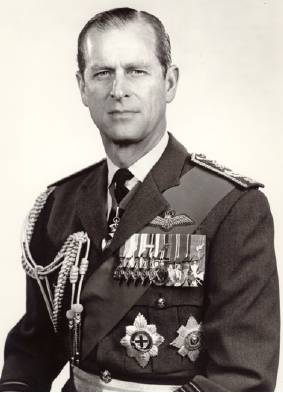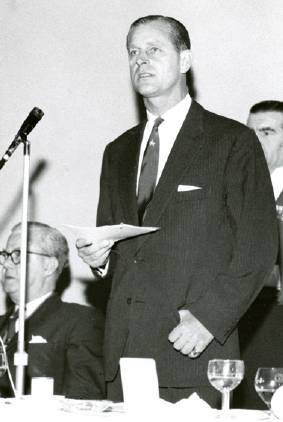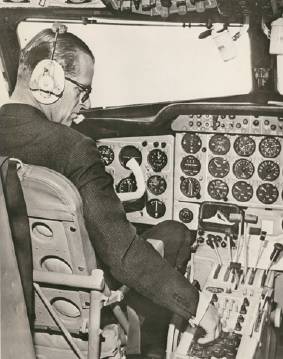Celebration of Life: His Royal Highness The Prince Philip, Duke of Edinburgh KG KT
The Duke of Edinburgh’s contribution and passion for aviation have been well emphasised and His Royal Highness made a significant contribution to the sector. In celebration of his life and, following the sad news of his death, the Royal Aeronautical Society would like to share some of our favourite memories, alongside some exclusive photos, audio and articles.
 HRH The Prince Philip, Duke of Edinburgh KG KT HonFRAeS, RAeS Honorary President 1966 10 June 1921 - 9 April 2021
HRH The Prince Philip, Duke of Edinburgh KG KT HonFRAeS, RAeS Honorary President 1966 10 June 1921 - 9 April 2021
His Royal Highness The Prince Philip, Duke of Edinburgh gained his RAF wings in 1953, his helicopter wings in 1956 and his private pilot’s licence in 1959. He achieved 5,986 hours in 65 types of aircraft and continued to fly until he was 75. Soon after gaining his licence, he began to fly a de Havilland Heron on loan from the Navy to fly himself to engagements. He also took opportunities to take the controls of Concorde, an Avro Vulcan and sat in the co-pilot seat in an English Electric Canberra during a visit to RAE Bedford in 1959. In the Boeing family, he flew the Stratocruiser, the 707, 727 and 757.
On 16 December 1954, HRH The Prince Philip, was presented with his Honorary Fellowship scroll by Sir Sydney Camm, RAeS President 1954-1955, at the Assembly Hall, Church House. Honorary Fellowship is the highest distinction for aerospace achievement and is awarded to only the most exceptional contributions to the aerospace profession.
 HRH The Prince Philip, Duke of Edinburgh, Honorary President, Royal Aeronautical Society, proposes the toast at the Luncheon given by the President and Council on 5 May 1966 at the Europa Hotel, London.
HRH The Prince Philip, Duke of Edinburgh, Honorary President, Royal Aeronautical Society, proposes the toast at the Luncheon given by the President and Council on 5 May 1966 at the Europa Hotel, London.
On the same night that he received his Honorary Fellowship, the Duke of Edinburgh delivered the Society’s tenth British Commonwealth and Empire Lecture entitled ‘Aviation and the Development of Remote Areas’. In the lecture, the Duke explores the vital and integral role of aviation for the benefit of agriculture, surveying, freight and much more. He challenged aircraft designers by saying:
“Aircraft must be simple, robust, and easy to maintain….. this does not mean that aircraft have to be slow. If high speed makes them more economical to operate, so much the better.”
The first Royal Aeronautical Society Handley Page Memorial Lecture was delivered by the Duke of Edinburgh at Cranfield on 21 May 1963, entitled ‘Education for Technology’. The lecture, focusing on technical education, was delivered in front of an audience of some 1,500 people.
Lord Brabazon of Tara gave an after-dinner speech at his 80th Birthday Dinner, organised by the Royal Aero Club, February 1964. The toast was proposed by HRH the Duke of Edinburgh and has been digitised.
 Left: The Duke of Edinburgh is presented with his Honorary Fellowship scroll by Sir Sydney Camm CBE FRAeS, RAeS President 1954-1955, at the Assembly Hall, Church House, Westminster, 16 December 1954. Middle: Later that evening he delivered the tenth British Commonwealth and Empire lecture, ‘Aviation and the development of remote areas’. Right: The Duke of Edinburgh, left, and Sir Frank Whittle view a Whittle jet engine at a dinner given by the Royal Aeronautical Society at the National Westminster Tower in 1987 to commemorate the 50th anniversary of the first running of the world’s first jet engine.
Left: The Duke of Edinburgh is presented with his Honorary Fellowship scroll by Sir Sydney Camm CBE FRAeS, RAeS President 1954-1955, at the Assembly Hall, Church House, Westminster, 16 December 1954. Middle: Later that evening he delivered the tenth British Commonwealth and Empire lecture, ‘Aviation and the development of remote areas’. Right: The Duke of Edinburgh, left, and Sir Frank Whittle view a Whittle jet engine at a dinner given by the Royal Aeronautical Society at the National Westminster Tower in 1987 to commemorate the 50th anniversary of the first running of the world’s first jet engine.
His Royal Highness went on to become the Royal Aeronautical Society’s Honorary President in 1966. In this capacity, he chaired the Society’s AGM on 5 May 1966. In the same year he attended the RAeS Centenary Congress and Fifth ICAS Congress on 12 September 1966 at the Royal Garden Hotel, London, delivering the address ‘Influences on the Development of Aviation’ and the Banquet at Grosvenor House the same evening. In the address, the Duke sets out the history and influence of the Royal Aeronautical Society, and more broadly of the developments in aviation over the years.
On 2 June 1973, the Royal Aeronautical Society was proud to host the Duke of Edinburgh at the RAeS Rotorcraft Section Helicopter Rally and Garden Party at Dunsborough Park.
HRH The Duke of Edinburgh attended a dinner given by the Royal Aeronautical Society at the National Westminster Tower in 1987 to commemorate the 50th anniversary of the first running of the world’s first jet engine. Sir Frank Whittle HonFRAeS was in attendance also.
30 October 1990 marked the 1,000th Council Meeting of the Royal Aeronautical Society, held in the Council Room at No.4 Hamilton Place. His Royal Highness attended the meeting and then inaugurated the then Rolls-Royce Suite in the basement of No.4.
 Left: The 1,000th Council Meeting of the Royal Aeronautical Society on 30 October 1990. Clockwise from centre back: G C Howell, President; The Prince Philip, Duke of Edinburgh, Hon Past-President; G M McCoombe, President Elect; AM Sir Frank Holroyd, Dr G G Pope, D J Williams, D Stinton, Prof M G Farley, AM M K Adams, P J Bennington, H McK Cowan, K S Danisman, A R Sharp, N Falconer, R J Forrester, Dr J E Green, J B Groves, AM Sir Donald Hall, D J Harper, Capt R L Jones, Prof M V Lowson, P G Richards, G Roe, Capt M C Russell, P R Sampson, I R Yates, D G Yeomans, Prof J L Stollery, Dr P H Calder, Dr H Metcalfe, A W L Nayler, Council Officer and R J Kennett, Director. Right: HRH The Duke of Edinburgh, right, is introduced to Sir Brian Burridge, then Chairman of the Air League, by Phil Boyle, then RAeS President, prior to the celebratory lunch to mark the inauguration of the Marshall of Cambridge Room at No.4 Hamilton Place on 19 October 2012. All photo RAeS (NAL).
Left: The 1,000th Council Meeting of the Royal Aeronautical Society on 30 October 1990. Clockwise from centre back: G C Howell, President; The Prince Philip, Duke of Edinburgh, Hon Past-President; G M McCoombe, President Elect; AM Sir Frank Holroyd, Dr G G Pope, D J Williams, D Stinton, Prof M G Farley, AM M K Adams, P J Bennington, H McK Cowan, K S Danisman, A R Sharp, N Falconer, R J Forrester, Dr J E Green, J B Groves, AM Sir Donald Hall, D J Harper, Capt R L Jones, Prof M V Lowson, P G Richards, G Roe, Capt M C Russell, P R Sampson, I R Yates, D G Yeomans, Prof J L Stollery, Dr P H Calder, Dr H Metcalfe, A W L Nayler, Council Officer and R J Kennett, Director. Right: HRH The Duke of Edinburgh, right, is introduced to Sir Brian Burridge, then Chairman of the Air League, by Phil Boyle, then RAeS President, prior to the celebratory lunch to mark the inauguration of the Marshall of Cambridge Room at No.4 Hamilton Place on 19 October 2012. All photo RAeS (NAL).
